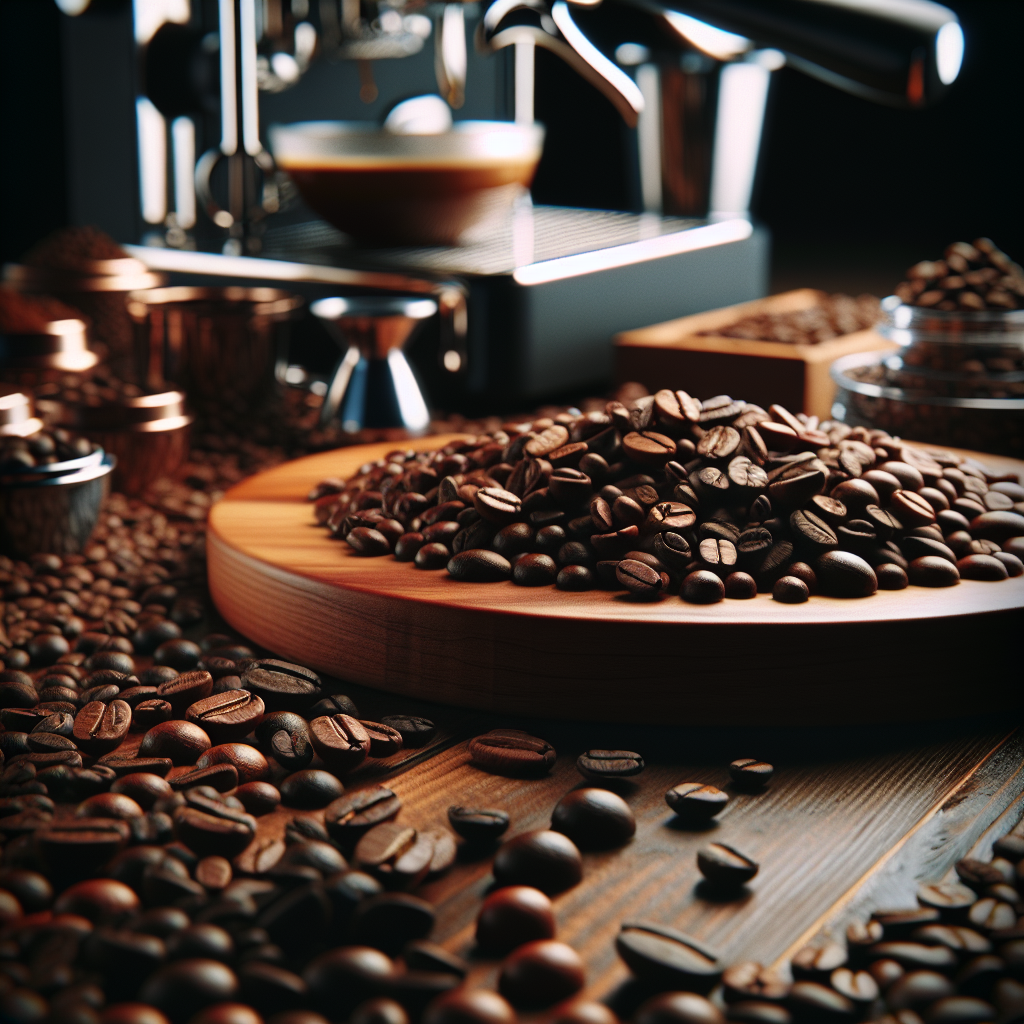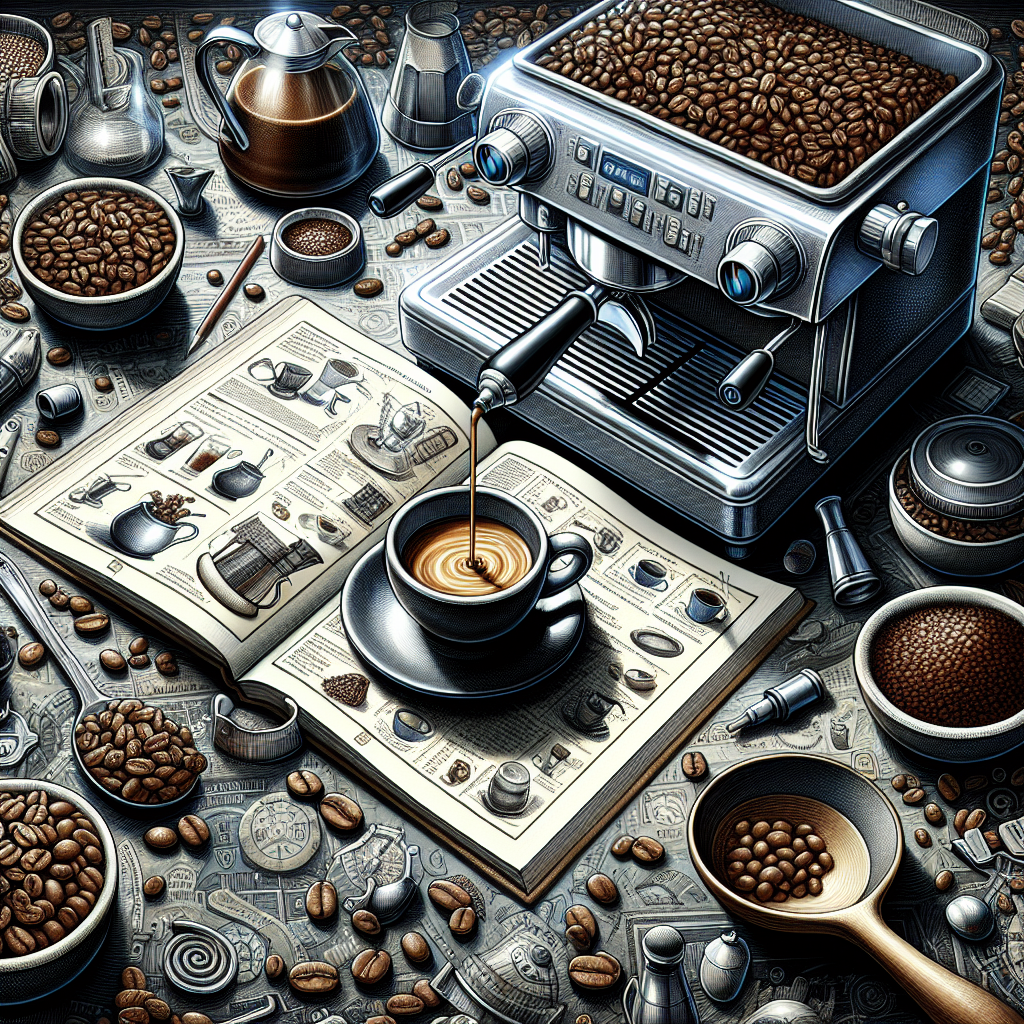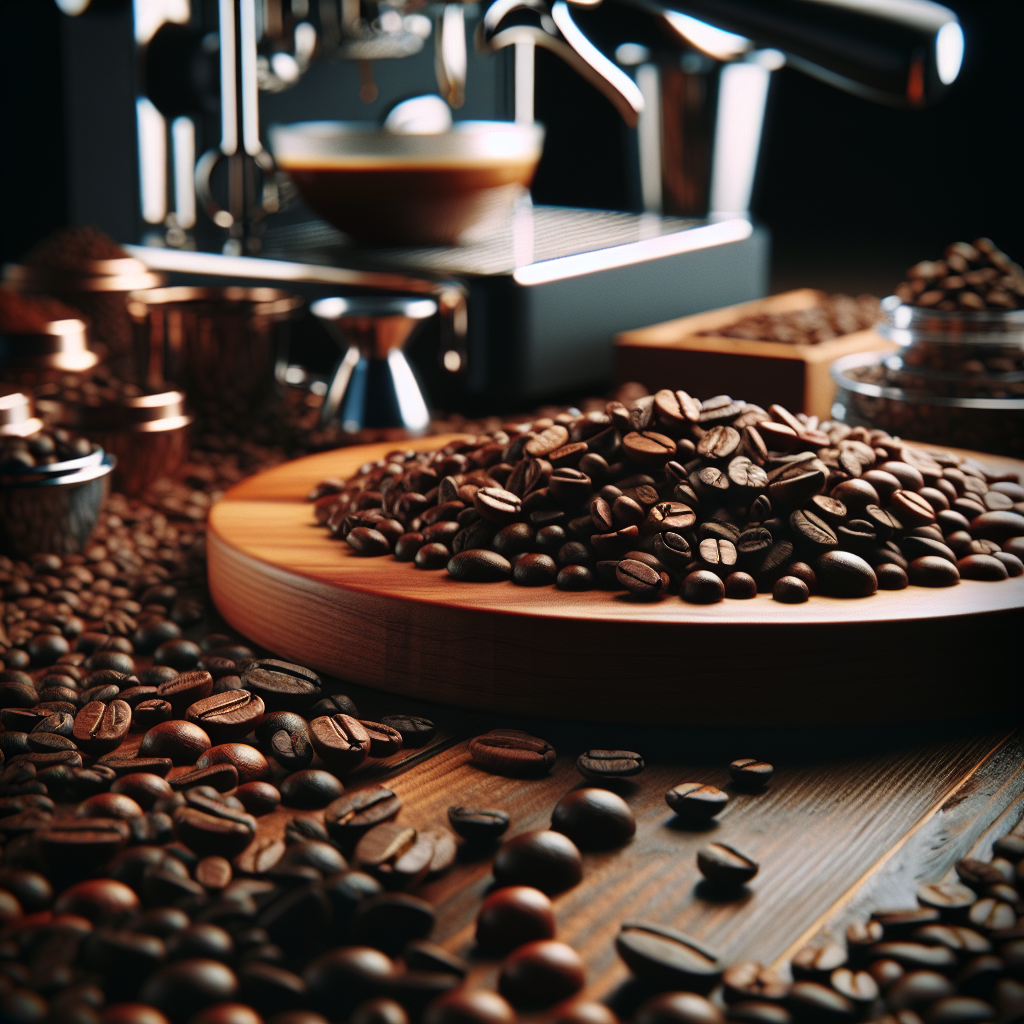So you’ve just invested in an espresso machine and you’re ready to dive into the world of brewing your own perfect shot. But where do you start? In this article, we’ll take you on a journey to discover the secrets of brewing the perfect espresso shot using different types of beans. Whether you prefer a bold and robust flavor or a subtle and smooth taste, we’ve got you covered. Get ready to unleash your inner barista and elevate your coffee game to a whole new level.

Selecting the Right Beans
Consider the Roast Level
When brewing espresso, one crucial factor to consider is the roast level of your beans. Each roast level has its own characteristics, and the choice ultimately depends on your personal taste preferences. Lighter roasts tend to have more acidity and a brighter flavor profile, while darker roasts often exhibit more smoky and bittersweet notes. Experiment with different roast levels to find the perfect balance of flavors that suits your palate.
Choose the Right Bean Origin
The origin of the coffee beans plays a significant role in the flavor profile of your espresso. Different regions produce beans with unique taste profiles, influenced by factors like climate, soil, and altitude. For example, beans from South America are known for their mild and balanced flavors, while African beans often boast fruity and floral notes. Consider exploring various bean origins to discover the flavors that resonate with you.
Use Freshly Roasted Beans
Once you have decided on the roast level and bean origin, it is crucial to use freshly roasted beans for the best possible espresso experience. Coffee beans are at their peak flavor within two to four weeks after roasting. Avoid purchasing large quantities of beans at once to ensure freshness. Look for local roasters or specialty coffee shops that roast their beans in small batches for maximum flavor and aroma.
Grinding the Beans
Invest in a Good Quality Grinder
To achieve the perfect espresso shot, investing in a high-quality grinder is essential. A burr grinder is the preferred choice as it provides a consistent grind size, crucial for even extraction. Blade grinders, on the other hand, can result in uneven particle sizes, leading to over-extraction or under-extraction. Consider factors such as grind speed, grind size adjustment options, and overall build quality when selecting a grinder.
Determine the Ideal Grind Size
The grind size of your coffee is another vital aspect to master for a perfect espresso shot. A too-fine grind can cause over-extraction and result in a bitter taste, while a too-coarse grind can lead to under-extraction and a weak flavor. Experiment with different grind sizes to find the sweet spot that produces a balanced and flavorful espresso. Keep in mind that different bean types and roast levels may require slight adjustments to the grind size.
Avoid Grinding Too Far in Advance
To preserve the freshness and flavors of your coffee, it is recommended to grind the beans just before brewing. Coffee grounds start to lose their aromatic compounds and flavors shortly after grinding due to exposure to air. To ensure the best-tasting espresso, try to minimize the time between grinding and brewing. It may be worth considering a grinder with a doser or doserless chute, allowing you to grind only what you need for each shot.
Dosing and Tamping
Understand the Importance of Dosing
Dosing refers to the amount of ground coffee used in the portafilter for each espresso shot. Consistency and accuracy in dosing are crucial for consistent extraction and flavor. The recommended dose for a double shot espresso typically ranges from 18 to 20 grams. Use a coffee scale to measure the appropriate amount of coffee for your chosen brewing ratio and adjust accordingly based on your taste preferences.
Use a Coffee Scale for Accuracy
To achieve precise and consistent dosing, using a coffee scale is highly recommended. Weighing the coffee grounds ensures that you have the correct amount for each shot, allowing for more control over the brewing process. Coffee scales are widely available and relatively affordable, making them an essential tool for any aspiring home barista. Take the time to calibrate your scale regularly to maintain accuracy.
Ensure Proper Tamping
Tamping is the process of evenly compacting the coffee grounds in the portafilter before brewing. It ensures a consistent flow rate and even extraction. Use a tamper that fits the size of your portafilter basket, applying firm and level pressure to create an evenly compressed coffee puck. Avoid applying excessive force, as this may lead to channeling, where water finds an easier path through the coffee grounds, resulting in uneven extraction.
Water Quality
Use Fresh and Filtered Water
The quality of water used for brewing espresso significantly impacts the overall taste of your shot. Always use fresh, preferably filtered water to avoid any unwanted flavors or impurities. Tap water can often contain chemicals such as chlorine or minerals that can alter the taste of your espresso. Investing in a water filter or using bottled water can help ensure a clean and pure brewing base.
Consider the Water Temperature
Water temperature plays a vital role in the extraction process and the resulting flavors in your espresso. The optimal water temperature for brewing espresso is between 195°F and 205°F (90°C and 96°C). Water that is too hot can lead to over-extraction and bitterness. Conversely, water that is too cool can result in under-extraction and a weak flavor profile. Maintain consistency by using a thermometer or a machine with precise temperature control.
Maintain Consistency
Consistency is key when brewing espresso. The water-to-coffee ratio, extraction time, and tamp pressure should remain constant from shot to shot, ensuring consistent flavors. By keeping these factors consistent, you can accurately evaluate the changes made to other elements, such as grind size or bean origin, to refine your brewing technique. Take notes and make adjustments accordingly to achieve your desired flavor profile.

Choosing the Right Portafilter
Single vs Double Shot
The choice between a single shot and a double shot portafilter depends on the amount of espresso you prefer and the number of servings you intend to make. Single shot portafilters typically hold around 7 grams of coffee and produce a smaller amount of espresso, suitable for a solo serving. Double shot portafilters, on the other hand, hold between 14 and 20 grams of coffee, providing a larger quantity for double shots or multiple servings.
Selecting the Basket Size
Portafilter baskets come in different sizes, allowing you to tailor the extraction to your desired taste. The size of the basket determines the strength and volume of the espresso shot. A smaller basket will result in a higher extraction pressure and a more concentrated flavor, while a larger basket will create a milder and more diluted shot. Experiment with different basket sizes to discover the extraction that suits your preference.
Temperature and Pressure
Preheat Your Equipment
Before brewing, it is essential to preheat your espresso machine, portafilter, and cups. Preheating helps maintain a stable brewing temperature and ensures consistent extraction and flavor. Running hot water through the portafilter and cups for a few seconds will help eliminate any residual heat and warm them up. Preheating also helps to prevent the espresso shot from losing heat too quickly after extraction, resulting in a hotter and more enjoyable drink.
Monitor the Brewing Temperature
Brewing espresso at the right temperature is crucial for optimal extraction. Temperatures that are too high can lead to over-extraction, while temperatures that are too low can result in under-extraction. It is advisable to use an espresso machine with precise temperature control or a separate thermometer to monitor the brewing temperature actively. Consistently brewing within the recommended temperature range ensures that you achieve the best flavors from your chosen beans.
Understand Optimal Extraction Pressure
Extraction pressure refers to the force at which water is pushed through the coffee grounds during brewing. Espresso extraction typically occurs at nine bars of pressure, which is considered the standard for achieving balanced flavors. High pressure can lead to over-extraction, resulting in a bitter taste, while low pressure may cause under-extraction, resulting in a weak and underwhelming shot. Most espresso machines are designed to provide optimal pressure, but it is important to ensure that your equipment is calibrated accordingly.
Brewing Time and Ratios
Optimal Extraction Time
The extraction time for an espresso shot typically ranges from 25 to 30 seconds. This timeframe allows for the extraction of the desirable flavors from the coffee grounds without extracting excessive bitterness. Monitoring the extraction time is crucial to achieving a well-balanced shot. Use a timer or a machine with built-in timing features to consistently brew within the recommended timeframe.
Understanding Brew Ratios
Brew ratio refers to the ratio of coffee to water used in the espresso extraction process. The standard brew ratio for espresso is typically 1:2, meaning one part of ground coffee to two parts of water. However, the brew ratio can be adjusted to suit personal preferences. A higher brew ratio, such as 1:3, will result in a more diluted and milder shot, while a lower ratio, such as 1:1.5, will produce a stronger and more concentrated espresso. Experiment with different ratios to find the balance that suits your taste.
Adjusting the Brew Time
Brew time can be adjusted to fine-tune the flavor profile of your espresso. By prolonging the brew time, more flavors can be extracted, resulting in a fuller-bodied and more intense shot. Conversely, a shorter brew time can produce a lighter and milder espresso. It is important to note that adjusting the brew time should be accompanied by corresponding changes in other factors, such as grind size and brew ratio, to maintain proper extraction.
Extraction Techniques
Traditional Espresso
Traditional espresso extraction is characterized by the use of a standard grind size and brew ratio, resulting in a well-balanced shot. It is the foundation for mastering other extraction techniques and flavors. The key is to achieve a harmonious blend of acidity, sweetness, and bitterness. Experimenting with different beans, roasts, and origins while adhering to the traditional extraction technique will allow you to uncover a wide variety of espresso flavors.
Ristretto
Ristretto is a type of espresso extraction that uses the same amount of coffee as a standard shot but with less water. This results in a shorter and more concentrated shot, emphasizing the sweetness and body of the espresso. The reduced water volume enhances the flavors while limiting the extraction of bitter compounds. Ristretto shots are often preferred by those who enjoy a more intense and flavorful espresso experience.
Lungo
Lungo, meaning “long” in Italian, is an espresso extraction that uses the same amount of coffee as a standard shot but with more water. This produces a longer and milder shot, with a higher brew ratio and a lighter overall flavor. Lungo shots are often favored by those seeking a milder and less concentrated espresso, as the extended brewing time allows for a gentler extraction of flavors. Experiment with different bean types and brew ratios to find your ideal lungo shot.
Taste Testing and Adjustments
Evaluate the Espresso Shot
After each extraction, it is important to evaluate the taste and quality of the espresso shot. Assess the flavors, aroma, and body, taking note of any nuances or deviations from your desired profile. Consider factors such as acidity, sweetness, bitterness, and balance. This evaluation allows you to identify any adjustments that may be necessary in terms of grind size, brew ratio, or extraction time to achieve the perfect espresso shot.
Adjusting the Grinder
Grind size is one of the most influential factors in espresso extraction. If the shot is tasting too sour or acidic, try adjusting the grind size finer. A coarser grind size can be beneficial if the shot is tasting bitter or over-extracted. Make small adjustments and taste the shot after each change to find the optimal grind size for your desired flavors. Take note of the adjustments made to maintain consistency in future brews.
Experiment with Variables
To truly master the art of brewing espresso, don’t be afraid to experiment with various variables. Try different bean origins, roast levels, grind sizes, brew ratios, and extraction times to uncover a variety of flavors and taste profiles. Keep a log of your experiments, noting the combinations that produce your favorite shots. Through trial and error, you’ll discover the perfect combination of variables that consistently deliver the espresso experience you desire.
Cleaning and Maintenance
Regular Cleaning of Equipment
Properly maintaining your espresso equipment is crucial for consistent flavor and performance. Regularly clean your grinder, espresso machine, and other brewing tools to prevent the buildup of coffee oils, stale grounds, and mineral deposits. Follow the manufacturer’s instructions for cleaning, ensuring that all removable parts are thoroughly cleaned and properly reassembled. Regular cleaning extends the lifespan of your equipment and helps maintain the flavors of your espresso.
Flush the Grouphead
Flushing the grouphead of your espresso machine is an important step in the cleaning process. Before and after each brew, run a small amount of water through the grouphead to remove any remaining coffee grounds or residue. This ensures a clean brewing environment and prevents any off-flavors from contaminating your espresso shot. Take care not to scald yourself with hot water during the flushing process.
Backflushing the Machine
Backflushing your espresso machine is a deeper cleaning method that helps remove oils, residue, and mineral buildup from various internal components. It involves using a blind filter and a cleaning agent specifically designed for espresso machines. Follow the instructions provided by the manufacturer or consult a professional to ensure proper backflushing technique. Regular backflushing improves the performance of your machine and helps maintain the quality of your espresso shots.
By following these comprehensive steps, you are well on your way to brewing the perfect espresso shot. Remember that practice, patience, and experimentation are key in mastering the art of espresso brewing. With the right beans, proper equipment, and a thorough understanding of the brewing process, you can indulge in a flavorful and satisfying espresso experience right from the comfort of your own home.

